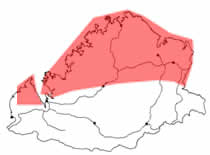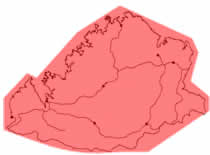Skinks are reptiles, reptiles are animals that are cold blooded, have scales and breath air. Skinks are small lizards, there are over 370 species in Australia, they are the most diverse group of vertebrates. Most have four legs, five fingers and toes, tails that can be regrown, shiny overlapping body scales and head scales arranged as symmetrical shields.
Due to the number of species identification can sometimes only be completed under a magnifying glass and counting scales. The book Lizards of Western Australia: Skinks, is a great resource for detailed identification of species. Skinks are most active during the day.
FACT: Skinks give birth to live young
FACT: Some skinks move more like a snake and have lost their arms and legs
Ref: Wilson, S. & Swan, G. “A Complete guide to reptiles of Australia.” New Holland Publishers.
|
“What’s in Your Backyard?”
Back to index |
 |
|
Kimberley Toad Busters |
What is A skink?
Key characteristics to look for when identifying species:
1st look at general body shape and pattern: Rainbow skink, Fence Skink, Striped Skink, Blue tongue or other.
No. of scales along the upper lip (labial scales)
Shape of ear opening and presence of lobes
Scales – ridges (keels) or individual colouring
Scales under fingers and toes (number and type)
Pattern and colour
Snout Vent Length
Vent is the external opening of the cloaca. The cloaca is the chamber where the reproduction and excretory ducts open.
There are 61 species of Skinks in the Kimberley, 25 species are endemic.
Only six common species are shown.
|
“What’s in Your Backyard?” |
|
 |
|
Kimberley Toad Busters |
Two-Spined Rainbow Skink
Carlia amax
Snout Vent Length: 4 cm
Distinguishing features: Four fingers
and five toes. Each scale on back
(dorsal) has two keels (ridges). Olive brown with pale and dark spots. Pale line under eye, passing the ear and reaching the forelimb.
|
 |
Top of head copper.
Habitat: Rock outcrops and slopes
Distribution: Kimberley, northern NT and QLD. |
|
Ref: Wilson S. & Swan G. “A complete guide to Reptiles of Australia”
Storr G. Smith L. and Johnstone R. “Lizards of Western Australia: Skinks.” |
|
|
 |
|
Kimberley Toad Busters |
Rainbow Skink
Carlia munda
Snout Vent Length: Up to 4.3 cm
Distinguishing features: Four fingers
and five toes. Each scale on back (dorsal)
is smooth or nearly smooth. Narrow white line running from upper lip to top of ear opening, continues from bottom of ear down side. Back and sides olive dotted with black and white |
 |
Breeding male has black flush on head and red flush on sides.
Habitat: Dry shrub or woodland or Spinifex on heavy/stony soils.
Distribution: Across northern Aust to Ipswich, QLD.
|
| |
Wall Lizard or Fence Skink
|
skink 9 |
|
 |
|
Kimberley Toad Busters |
Wall Lizard or Fence Skink
Cryptoblepharus plagiocephalus
Snout Vent Length: 4.5 cm
Distinguishing features: Highly variable.
Large circular eye, bottom eyelid fused to form spectacle. Around 5, usually 6 superarcillary (second row of scale above eye) scales. Bluntly keeled scales beneath toes and fingers. Scales on heels
|
 |
and palms pale and rounded. Grey to greyish brown to pale copper brown. Pattern of light and dark flecks with pale lines down each side may be present or absent.
Habitat: Variable, forests to rocky areas
Distribution: WA, NT, QLD, SA. Likely many undefined subspecies. |
 |
Ref: Wilson S. & Swan G. “A complete guide to Reptiles of Australia”
Storr G. Smith L. and Johnstone R. “Lizards of Western Australia: Skinks.” |
|
 |
|
Kimberley Toad Busters |
Striped Skink
Ctenotus inornatus
Snout Vent Length: 9.5 cm
Distinguishing features: Striped pattern
normally reduced but strong white
stripes (dorsolateral) down each side of body. Usually 8 scales under fingers and toes. Head and back dark brown to olive brown, paler towards tail. Limbs brown with dark streaks
|
 |
Habitat: Variety; rocky outcrops, riparian zones, sandy loam flats with woodlands, Spinifex or speargrass.
Distribution: Kimberley, Northern NT to Western QLD |
 |
Ref: Ref: Wilson S. & Swan G. “A complete guide to Reptiles of Australia”
Storr G. Smith L. and Johnstone R. “Lizards of Western Australia: Skinks.” |
“What’s in Your Backyard?”
Back to index
|
 |
|
Kimberley Toad Busters |
Common Grey Skink
Menetia greyii
Snout Vent Length: 3.8 cm
Distinguishing features: Very small, well
developed limbs with four fingers and
five toes. Three scales in a line between
eye and nostril. Brownish grey to grey with dashes along back. Broad dark and white stripes along sides.
|
|
Habitat: Dry areas with open vegetation
Distribution: WA, NT, QLD, NSW, Vic, SA
|
\\
© Sharon McLachlan
|
“What’s in Your Backyard?”
Back to index
|
 |
|
Kimberley Toad Busters |
Northern Blue-Tongue
Tiliqua scincoides (spp. intermedia and
scincoides)
Snout Vent Length: 30-32 cm
Distinguishing features: Long body with
thick tail, smooth scales and enlarged
long scales on temple. 6-9 palebands between neck and hips, with |
 |
7-10 on tail. Bands can be broken or faded by heavy mottling. Flushed with orange to yellow with black bars on flanks. Blue tongue!
Habitat: Northern Australia
Distribution: WA, NT and QLD
Ref: Ref: Wilson S. & Swan G. “A complete guide to Reptiles of Australia”
Storr G. Smith L. and Johnstone R. “Lizards of Western Australia: Skinks.” |



